Accepted Scientific Name: Lithops pseudotruncatella subs. dendritica
Lithops Flowering Stones 218 (1988)
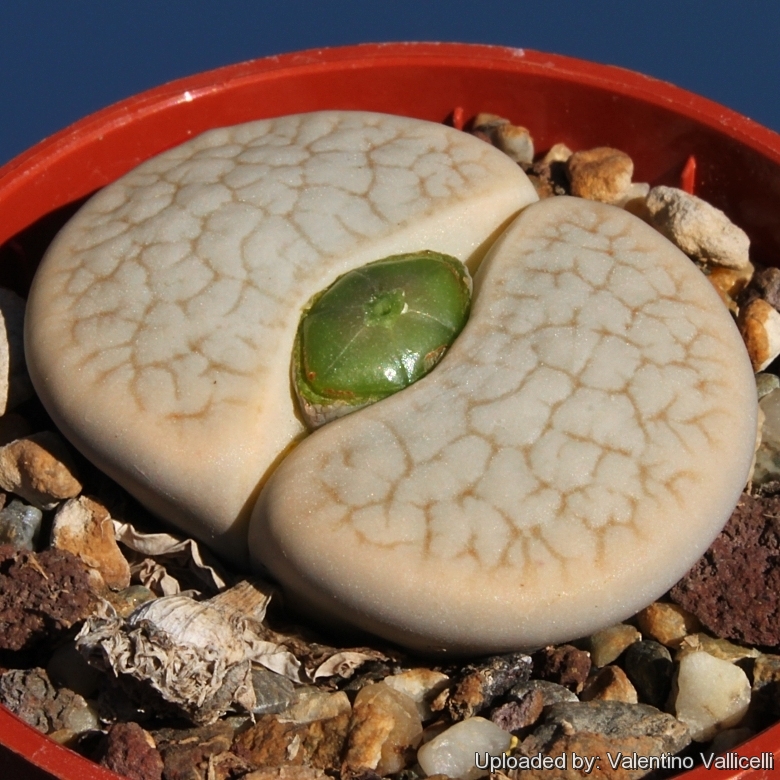
Lithops pseudotruncatella subs. dendritica C245 (syn. farinosa) 55 km SSW of Rehoboth, Namibia Photo by: Valentino Vallicelli
It has pale blue-grey to grey body with brown branched markings and is one the more robust and easy growing plants in the genus.
Origin and Habitat: Namibia, 55 km South-South-West of Rehoboth.
Habitat: It is found growing among quartzite and mica schist stones.
Synonyms:
See all synonyms of Lithops pseudotruncatella
back
Accepted name in llifle Database:Lithops pseudotruncatella (A.Berger) N.E.Br.Gard. Chron. Ser. 3., 71: 65. 1922Synonymy: 18
- Lithops pseudotruncatella (A.Berger) N.E.Br.
- Lithops pseudotruncatella var. alpina (Dinter) Boom
- Lithops pseudotruncatella var. alta Tischer
- Lithops pseudotruncatella C067 20 km ENE of Windhoek, Namibia
- Lithops pseudotruncatella C068 (syn. alpina) 35 km SSE of Windhoek, Namibia
- Lithops pseudotruncatella C070 30 km S of Windhoek, Namibia
- Lithops pseudotruncatella C099 (syn. mundtii) 150 km NE of Windhoek, Namibia
- Lithops pseudotruncatella C100 (syn. mundtii) 135 km NE of Windhoek, Namibia
- Lithops pseudotruncatella C263 20 km W of Windhoek, Namibia
- Lithops pseudotruncatella C264 (pallid Form) 60 km SSW of Windhoek, Namibia
- Lithops pseudotruncatella C315 20 km ENE of Windhoek, Namibia
- Lithops pseudotruncatella C381 (syn. alpina) TL: 30 km S of Windhoek, Namibia
- Lithops pseudotruncatella C413 100 km W of Windhoek, Namibia
- Lithops pseudotruncatella var. mundtii (Tischer) H.Jacobsen
Accepted name in llifle Database:Lithops pseudotruncatella subs. archerae (de Boer) D.T.ColeLithops Flowering Stones 217 (1988)Synonymy: 5
Accepted name in llifle Database:Lithops pseudotruncatella subs. dendritica (Nel) D.T.ColeLithops Flowering Stones 218 (1988)Synonymy: 15
Accepted name in llifle Database:Lithops pseudotruncatella var. elisabethiae (Dinter) de Boer & BoomSucculenta (Netherlands) 1961(6) 66-67, 69 [Jun. 1961] (non "elizabethae", "elisabethae".)Synonymy: 3
Accepted name in llifle Database:Lithops pseudotruncatella subs. groendrayensis (H.Jacobsen) D.T.ColeLithops Flowering Stones 222 (1988)Synonymy: 6
Accepted name in llifle Database:Lithops pseudotruncatella var. riehmerae D.T.ColeMadoqua 1: 45, 38. 1987 ; cf. Repert. Pl. Succ. (I.O.S.), 38: 5 (1987 publ. 1989) Locality not stated.Synonymy: 4
Accepted name in llifle Database:Lithops pseudotruncatella subs. volkii (Schwantes ex de Boer & Boom) D.T.ColeLithops Flowering Stones 233 (1988)Synonymy: 4
Cultivars
(1):
back
Common Names include:
ENGLISH: Living Stone, Stone Plant
ITALIAN (Italiano): Pianta Sasso
Description: Lithops pseudotruncatellaSN|13128]]SN|13128]] subs. dendritica “farinosa” (= Lithops farinosaSN|13143]]SN|13143]] Dinter) is a distinct variety which distinguishes from the other Lithops pseudotruncatellaSN|13128]]SN|13128]] subs. dendritica for the very pale, unique colouring and bodies regularly branched with channels and rubrications that forms an almost a honeycomb pattern. The seemingly very regular arid prominent impressed dendritic lines characterise this species, and no other species of this genus is so well marked in this respect as this one.
Habit: It is a very free-growing species, solitary or variously branched with 4 or more heads, but seldom more than 1, each heads consisting of a pair of succulent leaves.
Body (paired leaves): The body is medium to very large facial diameters up to 45 x 37 mm, mostly about 35 x 28 mm.. Leaves subequal, convex or plane; sides violaceous grey, window opaque, cream-coloured, rugose, between the slight elevations a large number of dendritic interconnected slightly honey-lines, these dendritic lines ending in bifurcations in the outer margin, inner margin bordered by irregular lines, round the upper surface a narrow cream-coloured band, 1-2 mm broad.
Flowers: Yellow, medium to very large, up to 50 mm in diameter.
Fruits: Seed capsules mostly 6-chambered.
Seeds: Light brown to brown.
Subspecies, varieties, forms and cultivars of plants belonging to the Lithops pseudotruncatella group
 Lithops pseudotruncatella (A.Berger) N.E.Br.: Cole numbers: C067, C070, C263, C315 “alpina”, C068, C381 “mundtii”, C099, C100 “clear form”.
Lithops pseudotruncatella (A.Berger) N.E.Br.: Cole numbers: C067, C070, C263, C315 “alpina”, C068, C381 “mundtii”, C099, C100 “clear form”.
It is a medium to very large sized elliptical plant about 40 X 30 mm wide, the body is flat to slightly convex with a shallow fissure,and lobes conjunct. It branches easily and forms clumps with up to 20 (or more) heads, but usually less. It is somewhat variable in colour, usually opaque, smooth to very slightly rugose, uniform pale grey or beige tinted with variously shaded. Face, margins and shoulders dull grey. Windows and margins usually not clearly distinguishable, In the upper surface there a broken network of irregularly and extensively branched tree-like rubrications that sometimes are reduced to a scattering of short lines, dashes and dots; the ends often finely ramose and tapering off into the outer margins.- Lithops pseudotruncatella var. alpina (Dinter) Boom: Lithops pseudotruncatella var. alpina is found in the Rusch Peak (namibia), situated in the middle of the southern boundary of the Lithops pseudotruncatella range, and is one of the few species which has settled at a height of up to 2420 metres.
 Lithops pseudotruncatella subs. archerae (de Boer) D.T.Cole: Cole numbers:C104, C306 This subspecies is easily recognized for its truncate profile and round-elliptic face, the uniform milky grey-green colour is also very characteristic of this plant.
Lithops pseudotruncatella subs. archerae (de Boer) D.T.Cole: Cole numbers:C104, C306 This subspecies is easily recognized for its truncate profile and round-elliptic face, the uniform milky grey-green colour is also very characteristic of this plant. Lithops pseudotruncatella subs. archerae C104 120 km NW of Maltahöhe, Namibia: grey green, stone-like.
Lithops pseudotruncatella subs. archerae C104 120 km NW of Maltahöhe, Namibia: grey green, stone-like. Lithops pseudotruncatella subs. archerae C306 TL: 120 km NW of Maltahöhe, Namibia: ex Type Locality, greyish green, big.
Lithops pseudotruncatella subs. archerae C306 TL: 120 km NW of Maltahöhe, Namibia: ex Type Locality, greyish green, big.- Lithops pseudotruncatella subs. archerae cv. Split Pea S.A.Hammer: Green form.
 Lithops pseudotruncatella C067 20 km ENE of Windhoek, Namibia
Lithops pseudotruncatella C067 20 km ENE of Windhoek, Namibia Lithops pseudotruncatella C068 (syn. alpina) 35 km SSE of Windhoek, Namibia: tiny bronze heads.
Lithops pseudotruncatella C068 (syn. alpina) 35 km SSE of Windhoek, Namibia: tiny bronze heads. Lithops pseudotruncatella C070 30 km S of Windhoek, Namibia: jagged red lines, dots.
Lithops pseudotruncatella C070 30 km S of Windhoek, Namibia: jagged red lines, dots. Lithops pseudotruncatella C099 (syn. mundtii) 150 km NE of Windhoek, Namibia: very broad round top.
Lithops pseudotruncatella C099 (syn. mundtii) 150 km NE of Windhoek, Namibia: very broad round top. Lithops pseudotruncatella C100 (syn. mundtii) 135 km NE of Windhoek, Namibia: reddish grey top, red lines.
Lithops pseudotruncatella C100 (syn. mundtii) 135 km NE of Windhoek, Namibia: reddish grey top, red lines.- Lithops pseudotruncatella C263 20 km W of Windhoek, Namibia: flowers in early summer.
 Lithops pseudotruncatella C264 (pallid Form) 60 km SSW of Windhoek, Namibia: pale marbles.
Lithops pseudotruncatella C264 (pallid Form) 60 km SSW of Windhoek, Namibia: pale marbles. Lithops pseudotruncatella C315 20 km ENE of Windhoek, Namibia
Lithops pseudotruncatella C315 20 km ENE of Windhoek, Namibia Lithops pseudotruncatella C381 (syn. alpina) TL: 30 km S of Windhoek, Namibia
Lithops pseudotruncatella C381 (syn. alpina) TL: 30 km S of Windhoek, Namibia- Lithops pseudotruncatella C413 100 km W of Windhoek, Namibia
 Lithops pseudotruncatella subs. dendritica (Nel) D.T.Cole: (Lithops farinosa Dinter.) Cole numbers: C072, C073, C357, C384, “farinosa” C245, “pulmonuncula” C071 [var. pulmuncola (Jacobsen) Jacobsen] This form is distinguishable for the more regularly branched channels and rubrications that forms an almost a honeycomb pattern. The face has usually a reddish colour.
Lithops pseudotruncatella subs. dendritica (Nel) D.T.Cole: (Lithops farinosa Dinter.) Cole numbers: C072, C073, C357, C384, “farinosa” C245, “pulmonuncula” C071 [var. pulmuncola (Jacobsen) Jacobsen] This form is distinguishable for the more regularly branched channels and rubrications that forms an almost a honeycomb pattern. The face has usually a reddish colour. Lithops pseudotruncatella subs. dendritica C071 (syn. pulmonuncula) TL: 50 km WNW of Rehoboth, Namibia: pink veins.
Lithops pseudotruncatella subs. dendritica C071 (syn. pulmonuncula) TL: 50 km WNW of Rehoboth, Namibia: pink veins. Lithops pseudotruncatella subs. dendritica C072 65 km WSW of Rehoboth, Namibia: has colourful branching lines.
Lithops pseudotruncatella subs. dendritica C072 65 km WSW of Rehoboth, Namibia: has colourful branching lines. Lithops pseudotruncatella subs. dendritica C073 95 km WSW of Rehoboth, Namibia: orange grey with lines.
Lithops pseudotruncatella subs. dendritica C073 95 km WSW of Rehoboth, Namibia: orange grey with lines. Lithops pseudotruncatella subs. dendritica C245 (syn. farinosa) 55 km SSW of Rehoboth, Namibia: pale, unique.
Lithops pseudotruncatella subs. dendritica C245 (syn. farinosa) 55 km SSW of Rehoboth, Namibia: pale, unique. Lithops pseudotruncatella subs. dendritica C357 75 km SW of Rehoboth, Namibia: fine etchings.
Lithops pseudotruncatella subs. dendritica C357 75 km SW of Rehoboth, Namibia: fine etchings.- Lithops pseudotruncatella subs. dendritica C384 6 km S of Rehoboth, Namibia
- Lithops pseudotruncatella var. elisabethiae (Dinter) de Boer & Boom: Cole numbers: C187 It is quite similar to the standard variety but with a peculiar bluish-pink colour.
 Lithops pseudotruncatella var. elisabethiae C187 TL: 55 km ESE of Otjiwarongo, Namibia (Dinter) de Boer & Boom: large pink bodies.
Lithops pseudotruncatella var. elisabethiae C187 TL: 55 km ESE of Otjiwarongo, Namibia (Dinter) de Boer & Boom: large pink bodies.- Lithops pseudotruncatella subs. groendrayensis (H.Jacobsen) D.T.Cole: Cole numbers: C239, C244 “Witkop form”, C246. Almost uniform pale grey-white in colour with minutely pin-pricked or wrinkled top surface.
- Lithops pseudotruncatella subs. groendrayensis C239 45 km SSE of Rehoboth, Namibia
 Lithops pseudotruncatella subs. groendrayensis C244 TL: 50 km S of Rehoboth, Namibia
Lithops pseudotruncatella subs. groendrayensis C244 TL: 50 km S of Rehoboth, Namibia Lithops pseudotruncatella subs. groendrayensis C246 (Witkop Form) 55 km S of Rehoboth, Namibia
Lithops pseudotruncatella subs. groendrayensis C246 (Witkop Form) 55 km S of Rehoboth, Namibia- Lithops pseudotruncatella var. mundtii (Tischer) H.Jacobsen
- Lithops pseudotruncatella f. pulmuncola Dinter in H.Jacobsen
- Lithops pseudotruncatella var. riehmerae D.T.Cole: “edithiae” (var. edithae) (N.E.Brown) De Boer) Cole numbers: C097 Not very different from the standard variety, it differs mainly in its generally smaller size. The head colour is pale grey colour with less extensive markings.
 Lithops pseudotruncatella var. riehmerae C097 (syn. edithiae) TL: 50 km SE of Windhoek, Namibia: milky grey.
Lithops pseudotruncatella var. riehmerae C097 (syn. edithiae) TL: 50 km SE of Windhoek, Namibia: milky grey. Lithops pseudotruncatella subs. volkii (Schwantes ex de Boer & Boom) D.T.Cole: Cole numbers: C069 The face of this form is pale bluish-white with very few rubrications and few or no dusky dots.
Lithops pseudotruncatella subs. volkii (Schwantes ex de Boer & Boom) D.T.Cole: Cole numbers: C069 The face of this form is pale bluish-white with very few rubrications and few or no dusky dots. Lithops pseudotruncatella subs. volkii C069 TL: 45 km S of Windhoek, Namibia: nearly white, stonelike.
Lithops pseudotruncatella subs. volkii C069 TL: 45 km S of Windhoek, Namibia: nearly white, stonelike.
Bibliography: Major refences and further lectures
1) Heidrun E. K. Hartmann “Aizoaceae F – Z” Springer 2002
2) Achim Hecktheuer “Mesembs, mehr als nur Lithops” Books on Demand GmbH Norderstedt. 2008
3) Desmond T. Cole & Naureen A. Cole, Uwe Beyer, Yves Delange “Les Lithops” SUCCULENTES Spécial 2008 AIAPS (now Terra seca). 2008
4) Desmond T. Cole & Naureen A. Cole “LITHOPS Flowering Stones” Cactus & Co. Libri. 2005
5) Yasuhiko Shimada “The Genus Lithops” Dobun Shoin. 2001
6) Rudolf Heine “Lithops - Lebende Steine” Neumann Verlag. 1986
7) Bernd Schlösser “Lithops – Lebende Steine” Praktische Anleitung für die Zimmerkultur. BussinessPoint MEDIA. 2000
8) Steven A. Hammer “Lithops – Treasures of the veld” British Cactus and Succulent Society. 1999
9) Desmond T. Cole “Lithops – Flowering Stones” Acorn Books 1988
10) Rudolf Heine “Lithops – lebende Steine” Neumann Verlag. 1986
11) David L. Sprechman “Lithops” Associated University Presses, Inc. 1970
12) Gert Cornelius Nel “Lithops” Hortors Limited, South Africa 1946
13) Edgar Lamb "The illustrated reference on cacti and other succulents" Blandford Press. 1978
14) Christopher Brickell, Royal Horticultural Society "RHS A-Z Encyclopedia of Garden Plants: K-Z., Volume 2" Kindersley, 2008
15) G. C . Nel “Lithops: Plantae succulantae, rarissimae, in terra obscuratae, e famailia Aizoaceae, ex Africa australi” Hortors Limited, Cape Town, South Africa 1946
16) Heidrun E. K. Hartmann "Illustrated Handbook of Succulent Plants: Aizoaceae F-Z" Springer, 2002
17) Steven A. Hammer "Lithops: Joyaux du veld" Editions Quae, 25/nov/2010
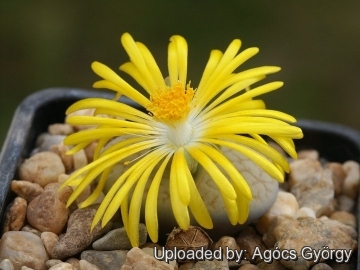 Lithops pseudotruncatella subs. dendritica C245 (syn. farinosa) 55 km SSW of Rehoboth, Namibia Photo by: Agócs György
Lithops pseudotruncatella subs. dendritica C245 (syn. farinosa) 55 km SSW of Rehoboth, Namibia Photo by: Agócs György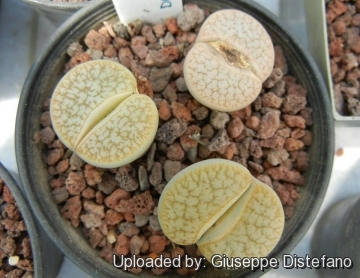 Lithops pseudotruncatella subs. dendritica C245 (syn. farinosa) 55 km SSW of Rehoboth, Namibia Photo by: Giuseppe Distefano
Lithops pseudotruncatella subs. dendritica C245 (syn. farinosa) 55 km SSW of Rehoboth, Namibia Photo by: Giuseppe Distefano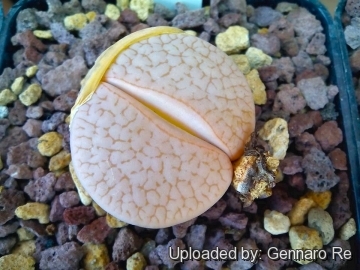 Lithops pseudotruncatella subs. dendritica C245 (syn. farinosa) 55 km SSW of Rehoboth, Namibia Photo by: Gennaro Re
Lithops pseudotruncatella subs. dendritica C245 (syn. farinosa) 55 km SSW of Rehoboth, Namibia Photo by: Gennaro Re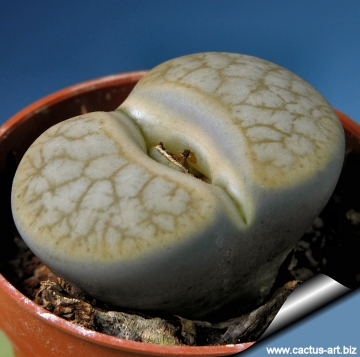 Lithops pseudotruncatella subs. dendritica C245 (syn. farinosa) 55 km SSW of Rehoboth, Namibia Photo by: Cactus Art
Lithops pseudotruncatella subs. dendritica C245 (syn. farinosa) 55 km SSW of Rehoboth, Namibia Photo by: Cactus Art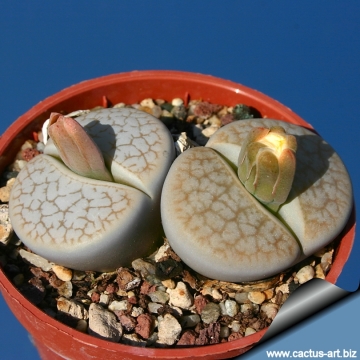 Lithops pseudotruncatella subs. dendritica C245 (syn. farinosa) 55 km SSW of Rehoboth, Namibia Photo by: Cactus Art
Lithops pseudotruncatella subs. dendritica C245 (syn. farinosa) 55 km SSW of Rehoboth, Namibia Photo by: Cactus Art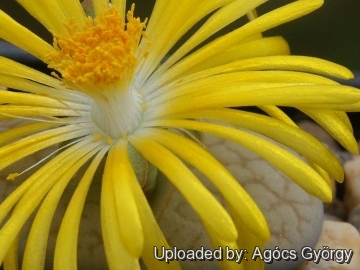 Lithops pseudotruncatella subs. dendritica C245 (syn. farinosa) 55 km SSW of Rehoboth, Namibia Photo by: Agócs György
Lithops pseudotruncatella subs. dendritica C245 (syn. farinosa) 55 km SSW of Rehoboth, Namibia Photo by: Agócs György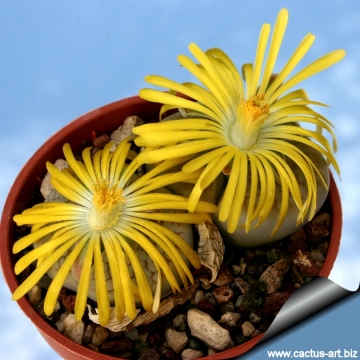 Lithops pseudotruncatella subs. dendritica C245 (syn. farinosa) 55 km SSW of Rehoboth, Namibia Photo by: Cactus Art
Lithops pseudotruncatella subs. dendritica C245 (syn. farinosa) 55 km SSW of Rehoboth, Namibia Photo by: Cactus Art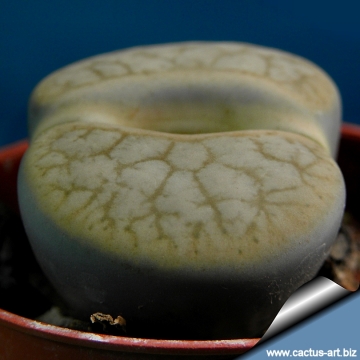 Lithops pseudotruncatella subs. dendritica C245 (syn. farinosa) 55 km SSW of Rehoboth, Namibia Photo by: Cactus Art
Lithops pseudotruncatella subs. dendritica C245 (syn. farinosa) 55 km SSW of Rehoboth, Namibia Photo by: Cactus ArtCultivation and Propagation: Lithops are partly subterranean, with only the clear 'window' in each leaf tip exposed above soil. A type of optical system exists whereby a layer of apical tissue rich in calcium oxalate crystals acts as a filter to intense sunlight before it reaches the thin chlorophyllous layer below. They are also called mimicry plants as they show a striking similarity to their background rocks and are difficult to detect when not in flower. These are the commonly known as pebble plants or living stones; each species is associated with one particular type of rock formation and occurs nowhere else. Its soil-embedded, subterranean growth form also reduces the need for chemical defences against herbivores.
Cultivation: Need an open mineral, fast draining mix and the maximum amount of light you are able to give them. The basic cultivation routine is: Stop watering after flowering. Start watering after the old leaves completely dry. (Usually late March or Early April) Water freely during the growing season, soak the compost fully but allow it to dry out between waterings, no water when cold. Some growers fertilize frequently, some hardly ever. Keep them dry during the winter. Nearly all problems occur as a result of overwatering and poor ventilation especially when weather conditions are dull and cool or very humid. This plant is best for a well lit area (Bright shade to full sun). But don't be afraid even the best growers have plants that mysteriously dry up, or leave during the night.
Note: After flowering in the autumn and extending through winter season the plant doesn’t need watering, but they will still be growing, the new bodies will be increasing in size extracting water from the outer succulent leaves, allowing them to shrivel away. In fact the plant in this time extracts water and nutrient stored in the outer succulent leaves, allowing them to dehydrate relocating the water to the rest of the plant and to the new leaves that form during this period until the old leaves are reduced to nothing more than "thin papery shells".
Your Photos
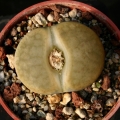
by Valentino Vallicelli

by Giuseppe Distefano
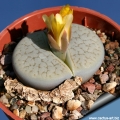
by Cactus Art
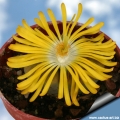
by Cactus Art






















